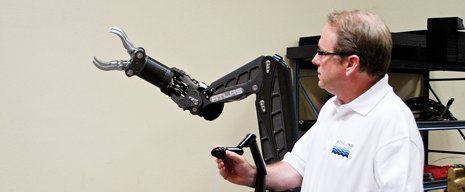Vol. 232 No. 10
NELL LUKOSAVICH, SENIOR EDITOR
|
Tyler Schilling
Where science fiction meets the seafloor
The idea of robots has captured the modern imagination since Isaac Asimov. For Tyler Schilling, founder and CEO of Schilling Robotics, the world of subsea automation is a new frontier that is just now being explored. Working to automate equipment 10,000 ft below sea level, Schilling is developing subsea robotics in a way that science fiction writers 10 years ago could not have even conjured up.
Schilling’s early career began far from the deep seas. After working as a mechanic on an automotive racing team, he went to work for Moller International, where he took charge of development of a vertical takeoff and landing aircraft. “The main influence that exposure to the aviation industry had on me was that it revealed a lot of clever design practices … for the physical weight and height constraints that they have to live with,” Schilling said.
Through Moller’s automotive division, Schilling met Wes Gerriets, who introduced him to oceanography. Gerriets eventually hired Schilling as a technical director into the oceanography department, which developed specialized equipment for use on remotely operated vehicles (ROVs).
In 1985, the two founded Schilling Development in a 400-sq-ft workspace, to develop robotic arms for ROVs. After extensive brainstorming, Schilling and his team developed a prototype for a manipulator arm (a precursor to the company’s Titan line of robotic arms), which they showed to potential customers. Over the next decade Schilling Robotics introduced a suite of new and upgraded manipulators to the market. In 1998, FMC Technologies purchased a 45% stake in Schilling Robotics.
With the boom in offshore exploration, where ROVs were being used in deeper, harsher environments, it was time to break the ROV mold once again. “The degree of automation and control of an ROV had been stagnant until 2001, when we introduced dynamic positioning to ROVs in the market,” said Schilling. “A lot of basic ROV technologies themselves didn’t have the fundamental control performance that was going to foster precise automatic control. We set about to develop a number of key building blocks for aspects of propulsion, sensing and control.”
In addition to introducing the latest HD ROV model in early 2011, Schilling Robotics has embarked on a new venture, partnering with Gregg Marine to build the first fully-automated subsea drilling system, the Seafloor Drill. The seabed drilling unit, originally conceived by John Gregg, is rated to 9,800-ft water depth and can drill 500 ft under the seabed. Schilling engineered the controls, power systems and subsea packaging.
The system recently underwent a series of successful tests offshore Vancouver, Canada. While initially developed for geotechnical surveying and core sampling, the companies see opportunities to incorporate downhole equipment management and geophysical tools.
With the goal of making smart machines even smarter, Schilling’s team recently added a new area of development dubbed “visual servoing.” The technology involves mounting a video camera on a manipulator arm with software capable of recognizing objects in the field of view and of controlling both the manipulator arm and the ROV based on the current position of those objects. “We can automatically plug a hot stab into a receptacle on a subsea structure, and all the operator does is point at it with his mouse,” said Schilling.
Today, Schilling Robotics holds 75% of the market share of deepsea ROVs. “It takes people to think about what’s possible and invent and then offer them to the market,” Schilling said. “The frontier kind of feel to it is really exciting. I’ve never really been drawn to wanting to make a marginally better solution to a problem that’s already been extremely well solved. It is much more exciting—to me at least—to work in a frontier area like this.” 
nell.lukosavich@worldoil.com
|



